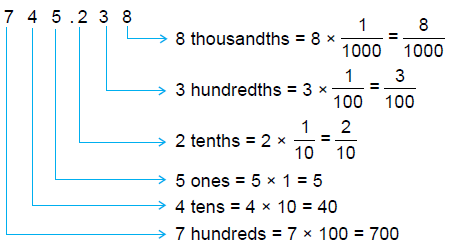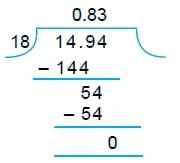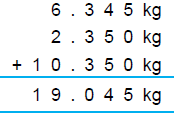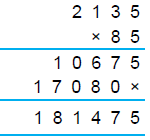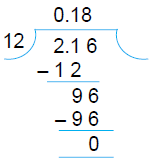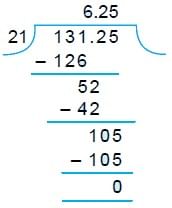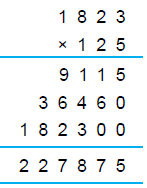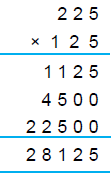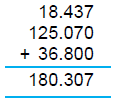Class 5 Maths - Decimals - Question Answers
Question 1: Write the place value of each digit of 745.238. Also, write 745.238 in the expanded form.
Arranging the digits of 745.238 in the place-value chart, we have
Thus,
Question 2: Multiply:
(a) 423.74 by 10
(b) 1,103.07 by 100
(c) 123.628 × 1,000
(a) 423.74 × 10 = 4,237.4
(b) 1,103.07 × 100 = 110,307.0
(c) 123.628 × 1,000 = 1,23,628.00
Question 3: Divide 13.47 by 3.
We have,
Hence, 13.47 ÷ 3 = 4.49
Question 4: Convert the following decimals into fractions.
(a) 3.9 (b) 5.67 (c) 0.287
(a) Consider 3.9
Since, there is only one digit immediately after the decimal point therefore,denominator of the fraction would contain 1 followed by only one zero.
Hence, 3.9 = 39/10
(b) 5.67Since, there are two digits immediately after the decimal point therefore,
denominator of the fraction would contain 1 followed by two zeros.
Hence, 5.67 = 567/100
(c) In 0.287, there are three digits immediately after the decimal point, therefore denominator of the fraction would contain 1 followed by three zeros.
Hence, 0.287 = 287/1,000
Question 5: Compare the following decimals :
2.147 and 2.18
We have 2.147 and 2.18,
2.18 = 2.180, so compare 2.147 and 2.180.
Comparing the whole number parts of the given decimals, we have 2 = 2
Now, comparing tenth digits, we have 1 = 1
Comparing hundredth digits, we have 4 < 8
Hence, 2.147 < 2.18
Question 6: A board 3.75 cm thick is glued to a board of thickness 4.375 cm. What is the combined thickness of the boards?
Thickness of one board = 3.75 cm.
Thickness of another board = 4.375 cm
Thickness of combined board = 8.125 cm
Hence, the thickness of combined board = 8.125 cm.
Question 7: Divide 14.94 by 18.
We have,
Hence, 14.94 ÷ 18 = 0.83
Question 8: Multiply : 6.73 by 8.
The given decimal (multiplicand) has two decimal places,
hence, 6.73 × 8 = 53.84.
Question 9: Express the following as directed :
(a) 5.3 cm as cm and mm
(b) 8.09 m as m and cm
(c) 16.354 kg as kg and g
(d) 21.008 l as l and ml
(a) 5.3 cm = 53/10 cm = 53mm
= 50 mm + 3 mm = 5 cm 3 mm(b) 8.09 m = 809/100 m = 809 cm
= 800 cm + 9 cm = 8 m 9 cm
(c) 16.354 kg = 16,354/1,000kg = 16354 g
= 16,000 g + 354 g = 16 kg 354 g(d) 21.008 l = 21,008/1,000 l = 21008 ml
= 21,000 ml + 8 ml = 21 l 8 ml.
Question 10: Subtract 8.007 from 15.3
Converting the given decimals into like decimals, we get 8.007, 15.300
Hence, 15.3 – 8.007 = 7.293.You can check your subtraction by adding the difference so obtained to the smaller number. If the result is the greater number, it means the subtraction is correct.
Question 11: Divide 112.36 by 8.
We have,
Hence, 112.36 ÷ 8 = 14.045
Question 12: The price of a watch is ₹ 225.60. Find the cost of 8 watches.
Cost of 1 watch = ₹ 225.60
Cost of 8 watches = ₹225.60 × 8
= ₹ 1804.80
Question 13: Ram purchased 6.345 kg rice, 2.350 kg sugar and 10.350 kg atta. Find the total weight of his purchases.
We have :
Quantity of rice purchased = 6.345 kg.Quantity of sugar purchased = 2.350 kg.
Quantity of atta purchased = 10.350 kg.
Total weight of his purchases is 19.045 kg.
Question 14: Multiply : 21.35 by 8.5
Sum of the decimal places in the given decimals = 2 + 1 = 3
So, the product contains 3 places of decimal.
Hence, 21.35 × 8.5 = 181.475.
Question 15: Write the following decimals in the place-value chart :
(a) 4.6
(b) 12.08
(c) 425.763
Arranging the digits of the given numbers in the place value chart, we have
Question 16: Divide
(a) 35.8 by 10
(b) 374.9 by 10
(a) 35.8 ÷ 10 = 3.58
(b) 374.9 ÷ 10 = 37.49
Question 17: The thickness of 12 sheets of paper is 2.16 mm. Find the thickness of 1 sheet.
Thickness of 12 sheets = 2.16 mm
Thickness of 1 sheet = 2.16 mm ÷ 12 = 0.18 mm.
Question 18: Write the number names of the following decimals:
(a) 0.08
(b) 35.28
(c) 218.035
(d) 0.0053
(e) 8.52
(a) 0.08 — zero point zero eight
(b) 35.28 — thirty five point two eight
(c) 218.035 — two hundred eighteen point zero three five.
(d) 0.0053 — zero point zero-zero five three
(e) 8.52 — eight point five two.
Question 19: Write the short form of 
= 2 hundreds + 5 tens + 3 ones + 8 tenths + 7 hundredths + 1 thousandth
= 253.871
Question 20: A vessel had 4.25 litres of milk. Out of it, a cat drank 0.375 litres. How much milk was left in the vessel?
Quantity of the milk in the vessel = 4.25 l
Quantity of milk drank by the cat = 0.375 l
Quantity of milk left in the vessel = (4.25 - 0.375) l = 3.875 l
Question 21: Divide 131.25 by 21.
We have,
Hence, 131.25 ÷ 21 = 6.25
Question 22: Multiply : 18.23 by 125.
Hence, 18.23 × 125 = 2278.75
Question 23: Convert the following into groups of like decimals :
21.2, 17.97, 208.3, 536.025
The maximum number of decimal places contained in the given group of decimal numbers is three. So, we convert each of the given decimals into an equivalent decimal having three decimal places, by putting zero or zeroes to the extreme right of the decimal part.
21.2 = 21.200
17.97 = 17.970
208.3 = 208.300
Clearly, 21.200, 17.970, 208.300 and 536.025 are like decimals.
Question 24: A car covers a distance of 22.5 km in one litre of petrol. How far can it go in 12.5 litres of petrol?
Distance covered by the car in 1 litre of petrol = 22.5 km.
∴ Distance covered by the car in 12.5 litre of petrol
= 22.5 km × 12.5
= 281.25 km
Question 25: Using decimals, convert as directed:
(a) 5 cm 8 mm into cm
(b) 12 m 72 cm into m
(c) 6 kg 91 g into kg
(d) 24 l 205 ml into l
(a) 5 cm 8 mm = 5 cm + 8/10 cm
= 5 cm + 0.8 cm = 5.8 cm
(b) 12 m 72 cm = 12 m + 72/100 m
= 12 m + 0.72 m = 12.72 m
(c) 6 kg 91 g = 6 kg +91/1,000 kg
= 6 kg + 0.091 kg = 6.091 kg
(d) 24 l 205 ml = 24 l + 205/1,000 l
= 24 l + 0.205 l = 24.205 l
Question 26: What must be subtracted from 6.75 to get 3.45?
The decimal to be subtracted = 6.75 – 3.45 = 3.30.
Hence, the required decimal to be subtracted is 3.30.
Question 27: Subtract 47.82 from 93.261 and check your subtraction.
Converting the given decimals into like decimals, we get 47.820 and 93.261
Hence, the subtraction is correct.
Question 28: Divide 0.9 by 10
0.9 ÷ 10 = 0.09.
Question 29: Write each of the following as decimals.
(a) 5/10
(b) 15/100
(c) 6/100
(d) 72/1,000
(a) 5/10 = 0.5
(b) 15/100 = 0.15
(c) 6/100 = 0.06
(d) 72/1,000 = 0.072
Question 30: Multiply : 3.25 by 0.7
Sum of the decimal places in the given decimals = 2 + 1 = 3
So, the product contains 3 places of decimal.
Hence, 3.25 × 0.7 = 2.275.
Question 31: Add : 18.437, 125.07 and 36.8
Converting the given decimals into like decimals,
we get 18.437, 125.070, 36.800
Hence, 18.437 + 125.07 + 36.8 = 180.307.
|
58 videos|122 docs|40 tests
|
FAQs on Class 5 Maths - Decimals - Question Answers
| 1. What are decimals? |  |
| 2. How do you read decimal numbers? |  |
| 3. How do you compare decimal numbers? |  |
| 4. How do you add and subtract decimal numbers? |  |
| 5. How do you multiply decimal numbers? |  |

|
Explore Courses for Class 5 exam
|

|

